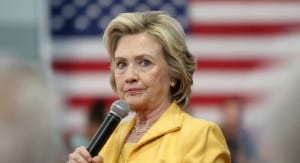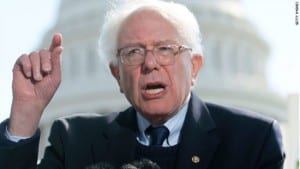By Frank Newport, Andrew Dugan and Glynn Wilson –
WASHINGTON, D.C. – As the Democrats gear up for their first nationally televised presidential debate Tuesday night, former Secretary of State Hillary Clinton maintains a higher net favorable rating among Democrats and Democratic-leaning independents than her closest rival, Vermont Senator Bernie Sanders, with a 12-point lead of 52 percent to 40 percent, according to the latest Gallup poll.
Clinton’s 12-point advantage is less than half of the lead she held back in July, however, when she was considered the clear front runner and the presumptive Democratic Party nominee for president.
“The smaller gap between Clinton and Sanders reflects changes in both candidates’ images in recent months,” according to Gallup’s analysis of the numbers.
Clinton and Sanders, along with three other announced but not as well-known Democratic candidates — Martin O’Malley, Jim Webb and Lincoln Chafee — will face off on Tuesday in Las Vegas. Vice President Joe Biden will not be on the stage since he’s still struggling with the decision to run or not.
Sanders’ net favorable image has increased from the +26 to +29 range in July and August to +40 in the past two weeks. Clinton’s, on the other hand, has gone from +60 to a low of +48 in early September before rising to the current +52.
Sanders increasingly popular progressive campaign has increased his name recognition among Democrats to 60 percent, up from 49 percent when Gallup began tracking this in mid-July, while well over nine in 10 Democrats are familiar with Clinton.
O’Malley’s, Webb’s and Chafee’s familiarity scores among Democrats were all under 30 percent when Gallup last tracked them in early September, with net favorable scores near zero among Democrats. Barring a last-minute entrance into the race by Vice President Joe Biden, the debate’s attention will focus on the two best-known candidates, Clinton and Sanders.
Clinton’s and Sanders’ images differ among certain segments of the Democratic base — particularly by race, education and age.
Clinton’s image is considerably more positive than Sanders’ among nonwhites in a large sample of Democrats. Clinton also has an advantage among those with a high school education or less, older Democrats, conservatives/moderates and women.
Sanders, on the other hand, ties or does better than Clinton among whites, those who have at least some college education, 18- to 29-year-olds, liberals and men. Perhaps most importantly, Sanders has a seven-point-higher net favorable rating among non-Hispanic white Democrats than Clinton, underscoring how much Clinton’s overall favorability advantage over Sanders is dependent on nonwhites. This particularly includes blacks, among whom Clinton’s net favorable rating is 55 points higher than Sanders’.
Clinton’s positive image also depends heavily on Democratic women, among whom Clinton’s net favorable rating is 23 points higher than Sanders’. The two candidates are essentially tied among Democratic men.
Sanders has an eight-point higher net favorable rating than Clinton among 18- to 29-year-old Democrats, and among Democrats with undergraduate degrees but no postgraduate study.
Gallup’s Bottom Line
Clinton began the 2016 Democratic campaign in much the same way she entered the 2008 Democratic primary, as the best-known, best-liked candidate and the one most pundits and political analysts viewed as the prohibitive front-runner.
“Her trajectory since the formal launch of her campaign this year has not been identical to the 2008 campaign,” Gallup says. “But in both instances, Clinton’s own missteps as well as the increasing popularity of a previously underestimated challenger have made the primary contest more competitive than initial assessments might have suggested.”
Clinton shares the debate stage Tuesday night with a challenger who has greatly narrowed her midsummer advantage in likability among Democrats, at a time when her favorability with national adults has fallen nearly to career lows for the longtime public figure.
“The two candidates have already developed distinctly different constituencies within the Democratic base, but it is uncertain how these strengths could play out in voting in the Democratic primaries,” Gallup concludes. “Older Democrats have a more positive image of Clinton than of Sanders — something that could play in her favor, given the traditionally higher turnout among older voters. On the other hand, Clinton’s less positive image among well-educated and liberal Democrats could hurt her if these groups turn out in significant numbers in the primaries.”
But the race is in an early stage, according to Gallup, and the performance of Clinton and Sanders in Tuesday’s debate — and Biden’s possible entry into the contest — may shake things up further. “As for the other three candidates, their inability to generate any traction with Democrats over the last several months suggests that this debate may be the point at which they turn their fortunes around, or totally fade into the background.”
Survey Methods
Results for this Gallup poll are based on telephone interviews conducted Sept. 12-Oct. 10, 2015, on the Gallup U.S. Daily survey, with a random sample of up to 5,943 U.S. adults identifying as Democrats or independents who lean Democratic, aged 18 and older, living in all 50 U.S. states and the District of Columbia. Each candidate was rated by a random subset of respondents during this period, with the sample sizes rating each candidate ranging from 1,903 to 1,964. For results based on these samples, the margin of sampling error is plus or minus 4 percentage points at the 95 percent confidence level.
Each sample of national adults includes a minimum quota of 60 percent cellphone respondents and 40 percent landline respondents, with additional minimum quotas by time zone within region. Landline and cellular telephone numbers are selected using random-digit-dial methods.















